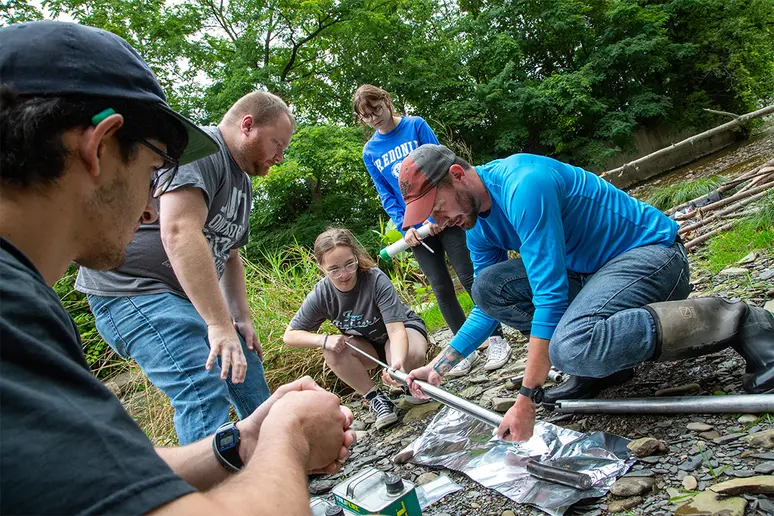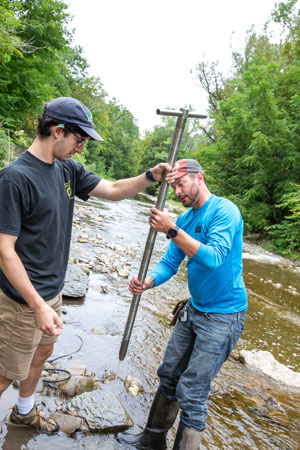

Sarah Wisinski (center) assists Randy Blood with removal of a segment of core from a hollow drill bit. There to assist are (from left): Hayden Backus, Dr. Thomas Hegna and Audrianna Sutton.


Sarah Wisinski (center) assists Randy Blood with removal of a segment of core from a hollow drill bit. There to assist are (from left): Hayden Backus, Dr. Thomas Hegna and Audrianna Sutton.
Science students on a field trip initiated by SUNY Fredonia alumnus Randy Blood literally had a direct hand in gathering samples of Devonian-aged rock that may help researchers to understand circumstances that lead to a major mass extinction event on earth millions of years ago.
A shale expert and field trip leader based in Pittsburgh, PA, Mr. Blood, who earned a B.S. in Geology in 2003, mentored students on drilling core techniques – how to bore into rock and remove successive cylindrical lengths of layers of that rock to reveal recorded earth history – at a location along Walnut Creek, near Silver Creek, NY.
“This is cutting edge research on a geological issue that today is poorly understood, and Fredonia students had an opportunity to be a part of that research.” - Randy Blood, '03
“Geologists have identified five mass extinctions – events where at least 50 percent on the low end to up to 96 percent on the high end of life forms became extinct – throughout earth history,” Blood explained.
“Of those five, we have a good understanding of what caused four of them; the one that we have the least understanding is the Late Devonian extinction,” Blood said.
That’s where SUNY Fredonia students enter the picture.
Working with Department of Geology and Environmental Sciences Associate Professor Thomas Hegna and Blood, students retrieved prized samples of Devonian rock that will be shipped to Germany for analysis at the University of Munster by members of the Subcommission on Devonian Stratigraphy, an organization comprised of scientists throughout the world dedicated to studying 60 million years of Devonian rock formations.
It’s the hope of these researchers that these sections of rock will reveal patterns of information about specific geologic cycles of earth history some 372 million years ago that resulted in this mass extinction. Researchers may potentially learn about the planet’s orbit around the sun, the tilt of its axis – factors that influence the amount of solar radiation the earth received which, in turn, results in global climatic changes.
The students – Audrianna Sutton (Environmental Sciences); Hayden Backus (Adolescence Education: Earth Science); Shaun Sanders (Geology); Richard Le (Writing, Geographic Information Systems minor); and Sarah Wisinski (Geology) – engaged in every phase of creek-side research during the September field trip.
Working in teams, students – who ranged from first-year to senior – became skilled in operating a gas-powered drill that allowed them bore through layers of shale and ultimately reach a depth of 30 feet by successively adding two-foot, hollowed-out cylindrical sections to extend the drill bit, as well as proper handling and wrapping the 15 sections of rock as each was withdrawn.

“We set up an assembly line as we worked; someone would drill, and then we would have people to pull up the segments of the drill bit, and then another group were wrapping and labeling the rocks that came up,” Dr. Hegna explained.
“Every two feet we would pop out the core and add another extender cylinder to the bit.”
“This is a pretty common (drilling) technique to figure out what is underneath the ground. People use this sort of approach in oil and gas, in metals mining – gold, silver, rare earths – and also in water aquifers, the studying of contaminants and a number of more environmental applications,” according to Hegna.
But opportunities for students to operate this kind of a drill are rare at undergraduate and graduate levels.
“We learned more about what could occur in this type of field research, in this instance, drilling cores through the first phase of extinction in the Upper Devonian layer of shale,” Mr. Sanders said.
“This experience has definitely given me a thought of what I would want to do as a job in the future but there are still many opportunities that I can take and think about which is why SUNY Fredonia Geology department is great because in this year and the past year, I’ve been given many opportunities like this by my professors.”
Ms. Wisinski found the field trip to be fascinating.
“It was especially insightful for me, a Geology major, to be involved in this outing because it gave me a great perspective on a possible career for me when I graduate,” she said “To be so up close and personal with something that interests me like this was an amazing learning experience and I was very fortunate to be included in this opportunity."
Operating a vertical boring tool that drills down through layers of rock makes it possible to collect a continuous core of rock, Blood explained, “so it allows us to capture those rocks that are not well exposed in Walnut Creek.”
That’s what makes the Silver Creek site, situated north of Route 20 in Chautauqua County, so valuable to researchers. There is another Devonian rock formation in Germany covering the same time interval, but it’s only a few meters, or about six feet, thick, thus limiting the amount of detail that can be examined.
“You’re trying to see detail, but have less visible space. All the patterns are compressed; it’s like you have fewer pixels,” Hegna explained.
But at Walnut Creek, the rock collected spanned a far greater distance – 30 meters (about 90 feet) – so each increment of rock revealed much greater detail that can be examined at a much higher resolution.
“This gives us an unprecedented understanding of what was happening in earth history in the time leading up to one of those horrible ecological crises in earth history,” Blood said.
It’s no surprise, then, that researchers come from all over the world to Western New York to examine Devonian rock exposures in a variety of different ways, he added.
Phenomenal is how Blood describe the students’ approach and execution of their assignments, indicating they were engaged and quickly mastered each step of the process. “I could trust one group to label and package the core, while working with another group collecting. I didn’t have to watch to be sure that no one made any mistakes.”
What spurred Blood to reach out to Hegna to assemble a team of student researchers was an appreciation of the integral role field work had during his education at SUNY Fredonia. “I wanted to provide an opportunity for the upcoming generation of students as well as exposure to different types of geology, wanted them to understand that the work that they’re doing is of incredible importance,” he stated.
“It’s nice to know there’s a school and faculty that can serve as a resource,” Blood noted.
“We set up an assembly line as we worked; someone would drill, and then we would have people to pull up the segments of the drill bit, and then another group were wrapping and labeling the rocks that came up.” - Dr. Thomas Hegna”
“This is cutting edge research on a geological issue that today is poorly understood, and Fredonia students had an opportunity to be a part of that research,” Blood said. “I know there are many things competing for their time, and they chose to go out on a field trip and do this kind of work. This means a lot to me.”
Blood brought impressive credentials to the field trip. He is an American Association of Petroleum Geologists (AAPG) certified petroleum geologist, has worked primarily in the oil and gas industry since 2006 and is widely published and the recipient of numerous awards.
Though he went on to earn a graduate degree in Geology at the State University at Buffalo, Blood cherishes his years at Fredonia. “I’ve always said that my time at Fredonia, working with professors, getting out in the field – those were formative years. I wanted to do something in geology, and Fredonia taught me how to learn, immersed me in geology and it was an experience – my watershed moment – reading those papers and taking classes, and then suddenly things start falling into place.”
He gave high praise to his Geoscience professors – Dr. Gary Lash, Dr. Gordon Baird, Dr. Walther Barnard and Dr. John Berkley. “They never hesitated to help a student work on a project. I am forever grateful for them and for Fredonia for that opportunity.”